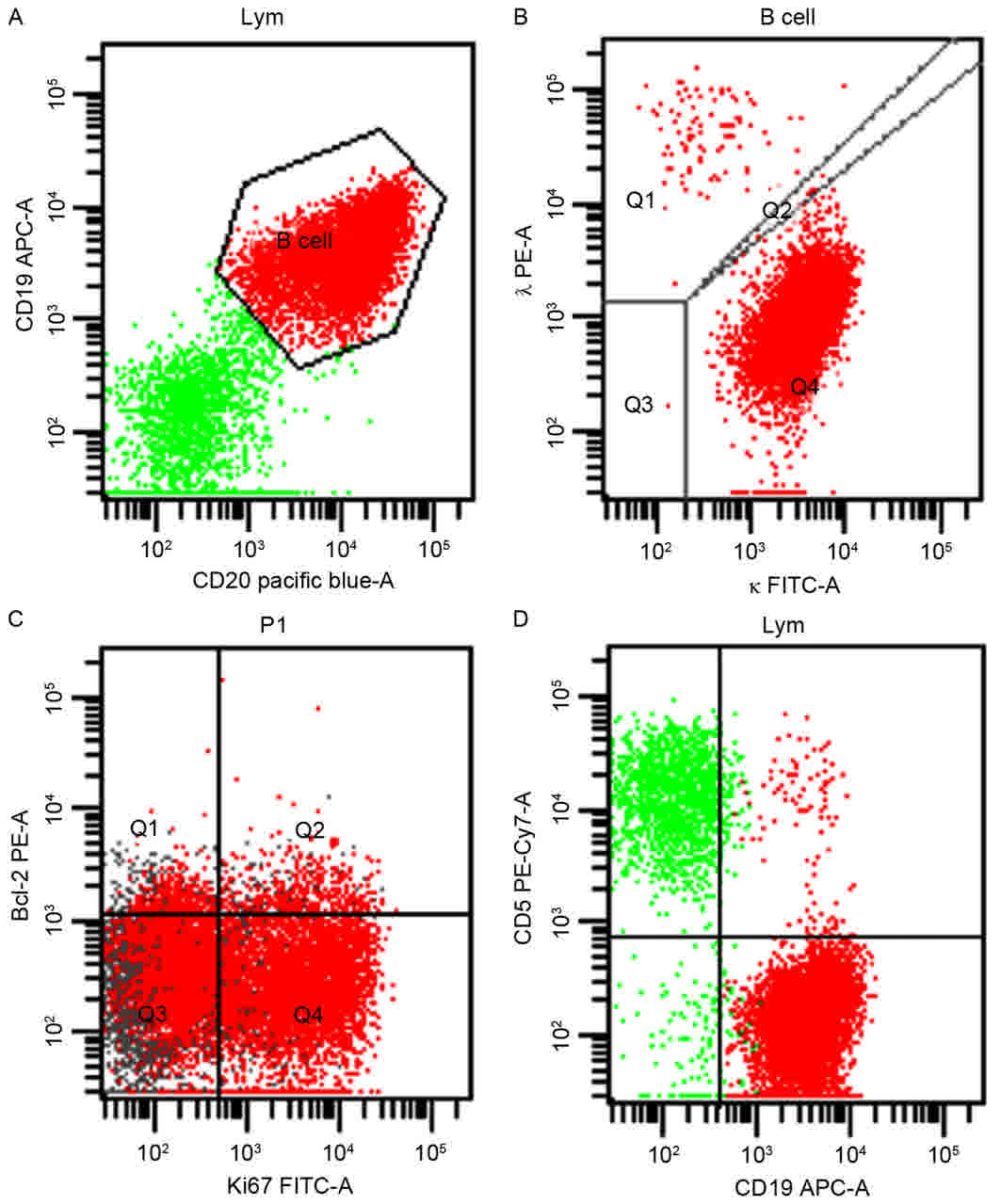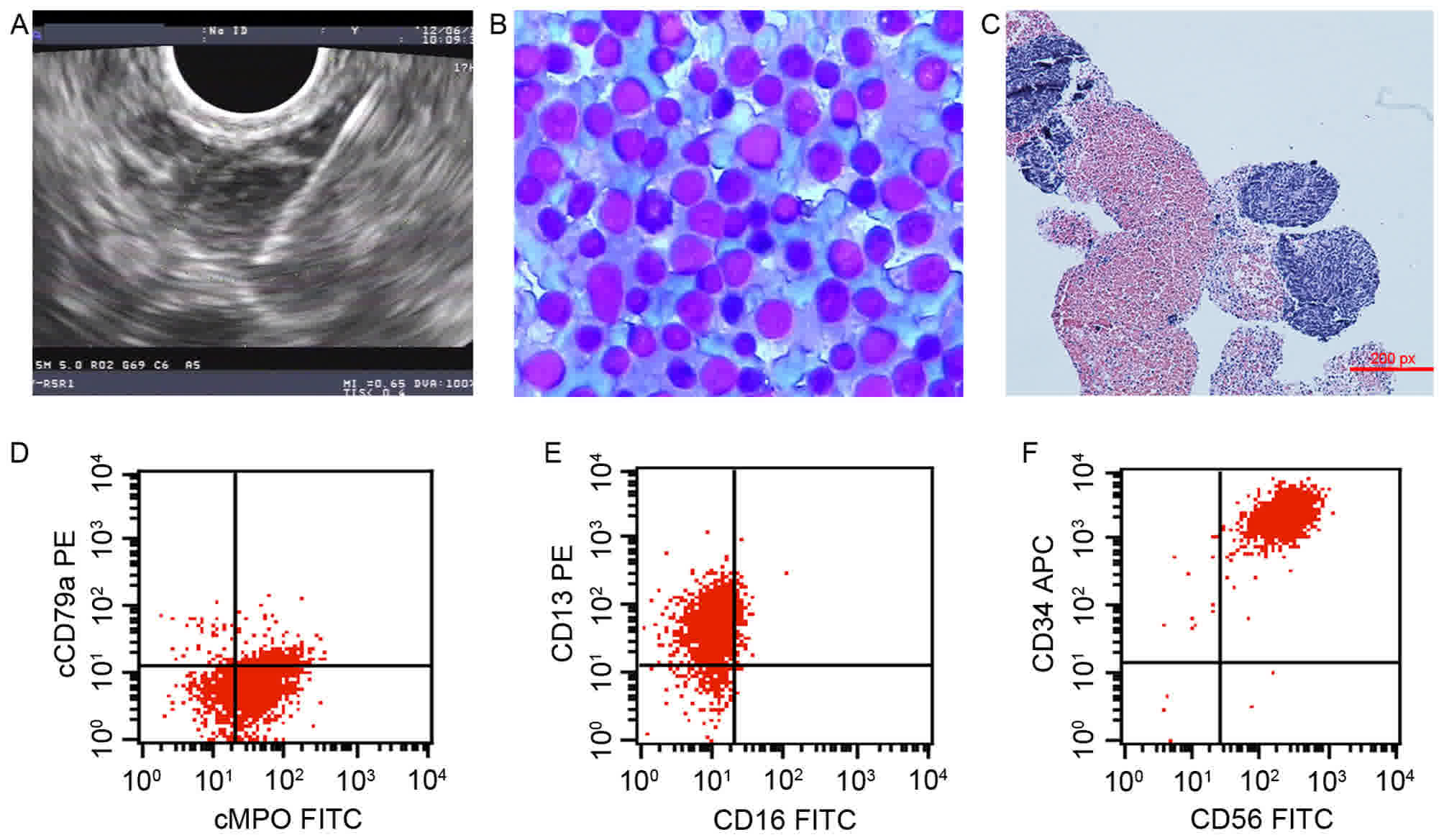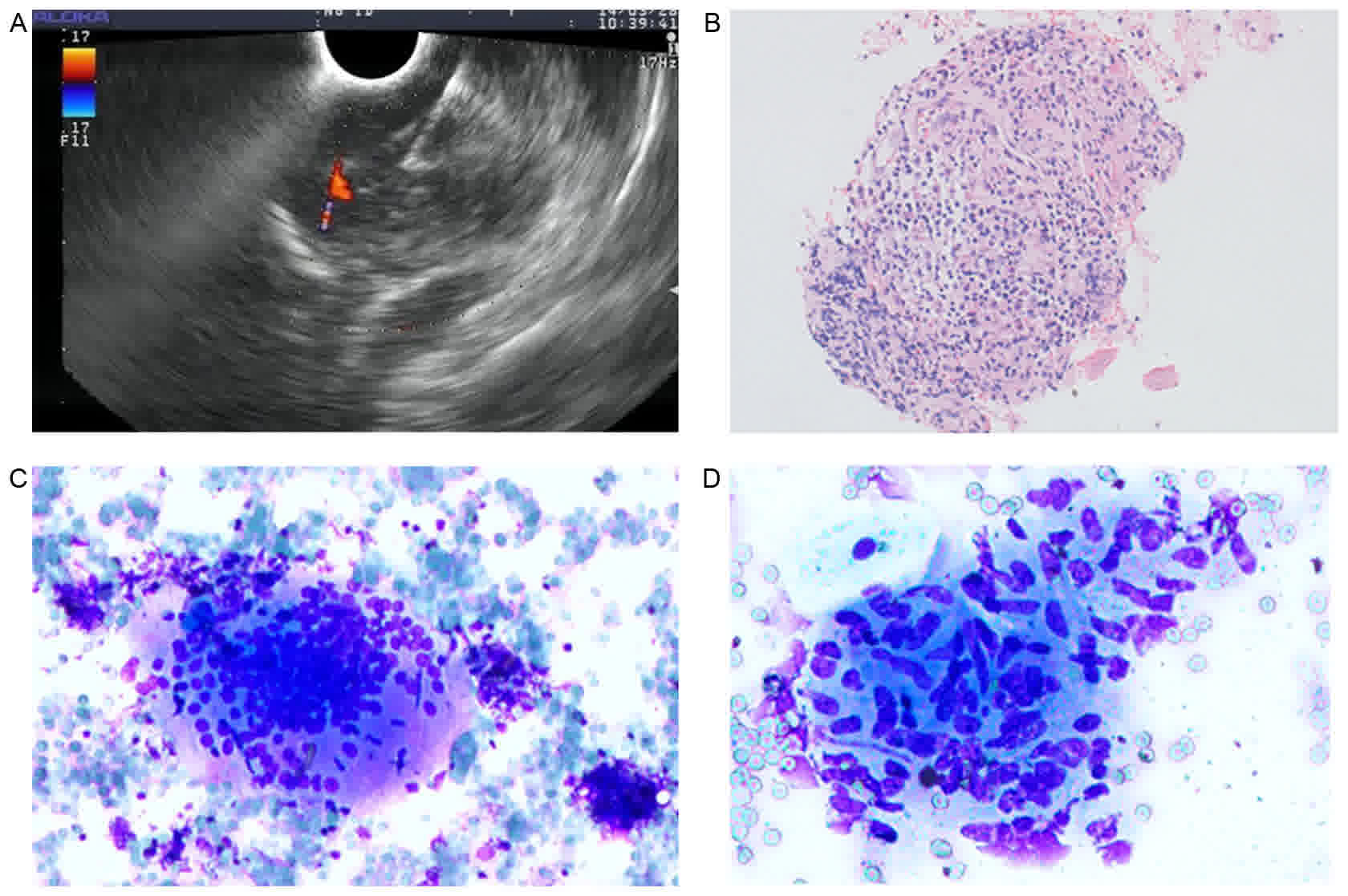|
1
|
Pugh JL, Jhala NC, Eloubeidi MA, Chhieng
DC, Eltoum IA, Crowe DR, Varadarajulu S and Jhala DN: Diagnosis of
deep-seated lymphoma and leukemia by endoscopic ultrasound-guided
fine-needle aspiration biopsy. Am J Clin Pathol. 125:703–709. 2006.
View Article : Google Scholar : PubMed/NCBI
|
|
2
|
Puri R, Vilmann P, Sud R, Kumar M, Taneja
S, Verma K and Kaushik N: Endoscopic ultrasound-guided fine-needle
aspiration cytology in the evaluation of suspected tuberculosis in
patients with isolated mediastinal lymphadenopathy. Endoscopy.
42:462–467. 2010. View Article : Google Scholar : PubMed/NCBI
|
|
3
|
Nakahara O, Yamao K, Bhatia V, Sawaki A,
Mizuno N, Takagi T, Shimizu Y, Koshikawa T, Yatabe Y and Baba H:
Usefulness of endoscopic ultrasound-guided fine needle aspiration
(EUS-FNA) for undiagnosed intra-abdominal lymphadenopathy. J
Gastroenterol. 44:562–567. 2009. View Article : Google Scholar : PubMed/NCBI
|
|
4
|
Hussain T, Salamat A, Farooq MA, Hassan F
and Hafeez M: Indications for endoscopic ultrasound and diagnosis
on fine-needle aspiration and cytology. J Coll Physicians Surg Pak.
19:223–227. 2009.PubMed/NCBI
|
|
5
|
Larsen SS, Vilmann P, Krasnik K, Dirksen
A, Clementsen P, Skov BG, Jacobsen GK, Lassen U, Eigtved A,
Berthelsen AK, et al: A comparison of endoscopic ultrasound guided
biopsy and positron emission tomography with integrated computed
tomography in lung cancer staging. Curr Health Sci J. 35:5–12.
2009.PubMed/NCBI
|
|
6
|
Strand DS, Jeffus SK, Sauer BG, Wang AY,
Stelow EB and Shami VM: EUS-guided 22-gauge fine-needle aspiration
versus core biopsy needle in the evaluation of solid pancreatic
neoplasms. Diagn Cytopathol. 42:751–758. 2014. View Article : Google Scholar : PubMed/NCBI
|
|
7
|
Mehmood S, Loya A and Yusuf MA: Clinical
utility of endoscopic ultrasound-guided fine-needle aspiration in
the diagnosis of mediastinal and intra-abdominal lymphadenopathy.
Acta Cytol. 57:436–442. 2013. View Article : Google Scholar : PubMed/NCBI
|
|
8
|
Jhala NC, Jhala D, Eltoum I, Vickers SM,
Wilcox CM, Chhieng DC and Eloubeidi MA: Endoscopic
ultrasound-guided fine-needle aspiration biopsy: A powerful tool to
obtain samples from small lesions. Cancer. 102:239–246. 2004.
View Article : Google Scholar : PubMed/NCBI
|
|
9
|
Chen VK and Eloubeidi MA: Endoscopic
ultrasound-guided fine needle aspiration is superior to lymph node
echofeatures: A prospective evaluation of mediastinal and
peri-intestinal lymphadenopathy. Am J Gastroenterol. 99:628–633.
2004. View Article : Google Scholar : PubMed/NCBI
|
|
10
|
Devereaux BM, Leblanc JK, Yousif E, Kesler
K, Brooks J, Mathur P, Sandler A, Chappo J, Lehman GA, Sherman S,
et al: Clinical utility of EUS-guided fine-needle aspiration of
mediastinal masses in the absence of known pulmonary malignancy.
Gastrointest Endosc. 56:397–401. 2002. View Article : Google Scholar : PubMed/NCBI
|
|
11
|
Sato M, Shirakami G and Fukuda K:
Comparison of general anesthesia and monitored anesthesia care in
patients undergoing breast cancer surgery using a combination of
ultrasound-guided thoracic paravertebral block and local
infiltration anesthesia: A retrospective study. J Anesth.
30:244–251. 2016. View Article : Google Scholar : PubMed/NCBI
|
|
12
|
Meda BA, Buss DH, Woodruff RD, Cappellari
JO, Rainer RO, Powell BL and Geisinger KR: Diagnosis and
subclassification of primary and recurrent lymphoma. The usefulness
and limitations of combined fine-needle aspiration cytomorphology
and flow cytometry. Am J Clin Pathol. 113:688–699. 2000.PubMed/NCBI
|
|
13
|
Young NA, Al-Saleem TI, Ehya H and Smith
MR: Utilization of fine-needle aspiration cytology and flow
cytometry in the diagnosis and subclassification of primary and
recurrent lymphoma. Cancer. 84:252–261. 1998. View Article : Google Scholar : PubMed/NCBI
|
|
14
|
Deans JP and Polyak MJ: FMC7 is an epitope
of CD20. Blood. 111(2492–2493): 24942008.
|
|
15
|
Jamil LH, Kashani A, Scimeca D, Ghabril M,
Gross SA, Gill KR, Hasan MK, Woodward TA, Wallace MB and Raimondo
M: Can endoscopic ultrasound distinguish between mediastinal benign
lymph nodes and those involved by sarcoidosis, lymphoma, or
metastasis? Dig Dis Sci. 59:2191–2198. 2014. View Article : Google Scholar : PubMed/NCBI
|
|
16
|
Nguyen TQ, Kalade A, Prasad S, Desmond P,
Wright G, Hart D, Conron M and Chen RY: Endoscopic ultrasound
guided fine needle aspiration (EUS-FNA) of mediastinal lesions. ANZ
J Surg. 81:75–78. 2011. View Article : Google Scholar : PubMed/NCBI
|
|
17
|
ASGE Standards of Practice Committee, .
Early DS, Acosta RD, Chandrasekhara V, Chathadi KV, Decker GA,
Evans JA, Fanelli RD, Fisher DA, Fonkalsrud L, et al: Adverse
events associated with EUS and EUS with FNA. Gastrointest Endosc.
77:839–843. 2013. View Article : Google Scholar : PubMed/NCBI
|
|
18
|
Yasuda I, Tsurumi H, Omar S, Iwashita T,
Kojima Y, Yamada T, Sawada M, Takami T, Moriwaki H and Soehendra N:
Endoscopic ultrasound-guided fine-needle aspiration biopsy for
lymphadenopathy of unknown origin. Endoscopy. 38:919–924. 2006.
View Article : Google Scholar : PubMed/NCBI
|
|
19
|
Catalano MF, Sivak MJ Jr, Rice T, Gragg LA
and Van Dam J: Endosonographic features predictive of lymph node
metastasis. Gastrointest Endosc. 40:442–446. 1994. View Article : Google Scholar : PubMed/NCBI
|
|
20
|
Kanamori A, Hirooka Y, Itoh A, Hashimoto
S, Kawashima H, Hara K, Uchida H, Goto J, Ohmiya N, Niwa Y and Goto
H: Usefulness of contrast-enhanced endoscopic ultrasonography in
the differentiation between malignant and benign lymphadenopathy.
Am J Gastroenterol. 101:45–51. 2006. View Article : Google Scholar : PubMed/NCBI
|
|
21
|
Song HJ, Kim JO, Eun SH, Cho YD, Jung IS,
Cheon YK, Moon JH, Lee JS, Lee MS, Shim CS, et al: Endoscopic
ultrasonograpic findings of benign mediastinal and abdominal
lymphadenopathy confirmed by EUS-guided fine needle aspiration. Gut
Liver. 1:68–73. 2007. View Article : Google Scholar : PubMed/NCBI
|
|
22
|
De Potter T, Flamen P, Van Cutsem E,
Penninckx F, Filez L, Bormans G, Maes A and Mortelmans L:
Whole-body PET with FDG for the diagnosis of recurrent gastric
cancer. Eur J Nucl Med Mol Imaging. 29:525–529. 2002. View Article : Google Scholar : PubMed/NCBI
|
|
23
|
Dewitt J, Ghorai S, Kahi C, Leblanc J,
McHenry L, Chappo J, Cramer H, McGreevy K, Chriswell M and Sherman
S: EUS-FNA of recurrent postoperative extraluminal and metastatic
malignancy. Gastrointest Endosc. 58:542–548. 2003. View Article : Google Scholar : PubMed/NCBI
|
|
24
|
Ribeiro A, Vazquez-Sequeiros E, Wiersema
LM, Wang KK, Clain JE and Wiersema MJ: EUS-guided fine-needle
aspiration combined with flow cytometry and immunocytochemistry in
the diagnosis of lymphoma. Gastrointest Endosc. 53:485–491. 2001.
View Article : Google Scholar : PubMed/NCBI
|
|
25
|
Nunez AL, Jhala NC, Carroll AJ, Mikhail
FM, Reddy VV, Xian RR and Jhala DN: Endoscopic ultrasound and
endobronchial ultrasound-guided fine-needle aspiration of
deep-seated lymphadenopathy: Analysis of 1338 cases. Cytojournal.
9:142012. View Article : Google Scholar : PubMed/NCBI
|
|
26
|
Kwong YL: Predicting the outcome in
non-Hodgkin lymphoma with molecular markers. Br J Haematol.
137:273–287. 2007. View Article : Google Scholar : PubMed/NCBI
|
|
27
|
Zinzani PL, Colecchia A, Festi D,
Magagnoli M, Larocca A, Ascani S, Bendandi M, Orcioni GF,
Gherlinzoni F, Albertini P, et al: Ultrasound-guided core-needle
biopsy is effective in the initial diagnosis of lymphoma patients.
Haematologica. 83:989–992. 1998.PubMed/NCBI
|
|
28
|
Neiman RS, Barcos M, Berard C, Bonner H,
Mann R, Rydell RE and Bennett JM: Granulocytic sarcoma: A
clinicopathologic study of 61 biopsied cases. Cancer. 48:1426–1437.
1981. View Article : Google Scholar : PubMed/NCBI
|
|
29
|
Bhandarkar DS, Shah RS, Katara AN, Shankar
M, Chandiramani VA and Udwadia TE: Laparoscopic biopsy in patients
with abdominal lymphadenopathy. J Minim Access Surg. 3:14–18. 2007.
View Article : Google Scholar : PubMed/NCBI
|
|
30
|
Puri R, Mangla R, Eloubeidi M, Vilmann P,
Thandassery R and Sud R: Diagnostic yield of EUS-guided FNA and
cytology in suspected tubercular intra-abdominal lymphadenopathy.
Gastrointest Endosc. 75:1005–1010. 2012. View Article : Google Scholar : PubMed/NCBI
|












